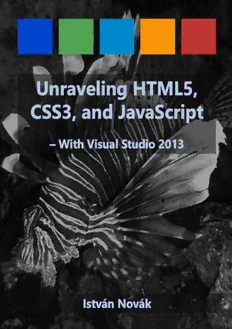
Unraveling HTLM5, CSS3, and JavaScript Unraveling Bootstrap 3.3 PDF
Preview Unraveling HTLM5, CSS3, and JavaScript Unraveling Bootstrap 3.3
Unraveling HTML5, CSS3, and JavaScript with Visual Studio 2013 By István Novák Copyright © 2014 by István Novák No part of this publication may be reproduced, stored in a retrieval system or transmitted in any form or by any means, electronic, mechanical, photocopying, recording, scanning or otherwise, without the prior written permission of the Author. Disclaimer: The Author makes no representations or warranties with respect to the accuracy or completeness of the content of this work and specifically disclaims all warranties, including without the limitation warranties of fitness for a particular purpose. To Henriett, Eszter and Reka, who supported me in writing this book with their love and appreciation Table of Contents About the Author Introduction Whom This Book Is For What You Need to Use This Book What This Book Covers Conventions Chapter 1: A Short Tour of HTML, CSS, and JavaScript Creating a Basic HTML Page Formatting the HTML Page Using Inline Styles Using an Embedded Style Sheet Moving Styles into a Separate File Defining Visual Behavior with CSS Adding Actions to the Web Page with JavaScript Leveraging Page Inspector Using jQuery Debugging JavaScript Summary Chapter 2: Getting to Know HTML5 The Unordinary Story of HTML5 What Behind the Term HTML5 Is HTML5 Markup Basics Using HTML <head> Defining HTML Content A Few Tricks to Edit HTML Markup with Visual Studio 2013 Enriching Web Pages with Headings, Lists, Links, and Images Summary Chapter 3: Achieving Richer User Experience with HTML Old Style: The Omnipotent <div> Structure and Semantics Tables Using Multimedia Summary Chapter 4: Forms and Controls Web Forms Basics Using Controls to Build Web Forms Sending and Processing Form Data More Controls Form Validation Summary Chapter 5: A Few More Things about HTML Other HTML Elements Refining Markup Details Painting the Canvas Facing with the Past and Future of HTML5 HTML5 Tools Summary Chapter 6: Exploring the Document Object Model DOM Basics What the DOM Covers Navigating in the Document Tree Changing the Document Tree Global Attributes and Events Using the DOM with jQuery Summary Chapter 7: Getting to Know JavaScript A Couple of JavaScript Peculiarities Placing JavaScript in HTML JavaScript Syntax Basics Variables, Types, and Scopes The Boolean Type The Number Type The String Type The Date Type The Object Type The Array Type Operators Flow-Control Statements Summary Chapter 8: Advanced JavaScript Programming The JavaScript Object Notation Functions Programming with Objects The Browser Object Model Error Handling Summary Chapter 9: Getting to Know Cascading Style Sheets Styles and Style Sheets Selectors Style Properties The Cascading Order Media-Dependent Style Sheets Summary Chapter 10: Basic Style Patterns Text Formatting The Box Model Using Background Images Styling Tables Styling Tips for Forms Summary About the Author Istvan Novak is an associate and the chief technology consultant of SoftwArt, a small Hungarian IT consulting company. He works as a software architect and community evangelist. In the last 20 years, he participated in more than 50 enterprise software development projects. In 2002, he co-authored the first Hungarian book about .NET development. In 2007, he was awarded with the Microsoft Most Valuable Professional (MVP) title, and in 2011 he became a Microsoft Regional Director. As the main author, he contributed in writing the Visual Studio 2010 and .NET 4 Six-In-One book (Wiley, 2010), and in Beginning Windows 8 Application Development (Wiley, 2012). He is the main author of Beginning Visual Studio LightSwitch Development book (Wiley, 2011). István holds master’s degree from the Technical University of Budapest, Hungary, and also has a doctoral degree in software technology. He lives in Dunakeszi, Hungary, with his wife and two teenage daughters. He is a passionate scuba diver. You may have a good chance of meeting him underwater at the Red Sea in any season of the year. Introduction It is incredible how web development has evolved in the last couple of years! While about five or six years ago most web pages were penurious compared to native desktop or mobile applications, nowadays many new sites provide competitive user experience— moreover, desktop applications started to copy the style of web apps. Even for web developers, it is a real challenge to cope with the flood of new technologies, libraries, and tools. HTML5, CCS3, jQuery, AngularJS, Ember, Bootstrap, Knockout, MVVM, LESS, JavaScript, CoffeeScript, TypeScript, and many more are all here to help creating web UI with great productivity and high-value user experiences. PHP, ASP.NET, Google Web Technologies, Ruby on Rails, Python, and a great number of other technologies empower developers to create fast and scalable back-ends for web sites. Amazon Web Services, Windows Azure, Google Cloud Platform, and other competitors offer you cloud services to deploy your applications to. How in this fast-turning world can a developer from the old school keep up with the youngsters who were breastfed with web programming? How can developers exiled to the server side for a while undertake the challenge of getting acquainted with these new technology racehorses? Getting all the knowledge to catch up with what’s going on nowadays is not easy at all. As an experienced C# programmer and enterprise architect, I found myself in a strange situation after 20 years of experience. Even if I worked on project teams that implemented big systems including satellite web sites, I was dropped behind those team members who started their professional life pretty close to new generation—neat, asynchronous, dynamic, etc.—web page development. It took months to find the right way to be able to communicate with them, and find the common language with them. During these months I read many books, blog posts, articles, and went through many small programming exercises to get into the picture. Well, I decided to create a series of booklets using my experiences—to help you cope with similar situations.
